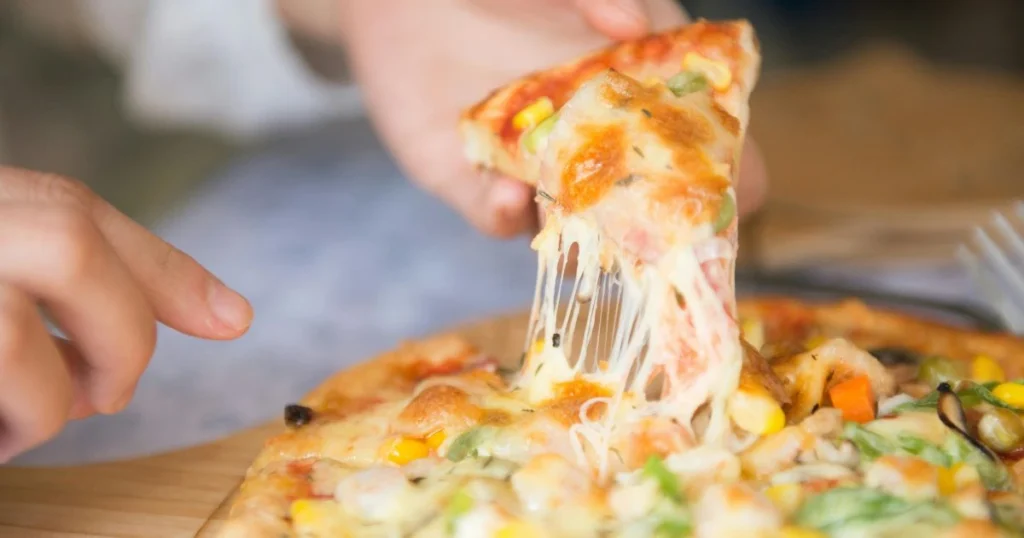Can Dogs Eat Pizza? The Complete Guide for Pet Parents
It’s Friday night, you’re relaxing on the couch with a delicious slice of pizza in hand, and there they are—those big, pleading eyes staring up at you from beneath the coffee table. Your furry best friend is giving you that look, the one that says, “Please, just one tiny bite?”
While sharing food with our canine companions might seem like an act of love, you might want to think twice. Is pizza bad for dogs? The short answer is yes—pizza is generally not a safe or healthy treat for dogs, despite how much they might beg for it. Many Dangerous Pizza Ingredients for Dogs, such as garlic, onions, high-fat cheeses, and processed meats, can lead to serious health issues.
In this comprehensive guide, we’ll explore can dogs eat pizza and why it can be problematic for your pooch, which Dangerous Pizza Ingredients for Dogs pose the greatest risks, what to do if your dog does snag a slice, and some delicious dog-friendly alternatives that will keep both you and your furry friend happy.
Table of Contents
The Short Answer: Can Dogs Eat Pizza? (And Why Not?)
No, dogs should not eat pizza. While a tiny nibble of plain crust might not cause immediate harm to most healthy adult dogs, pizza as a whole contains several ingredients that range from mildly problematic to potentially toxic for our canine companions.
The main reasons pizza is bad for dogs include:
- Many common pizza toppings (like onions and garlic) are toxic to dogs
- The high fat content can trigger pancreatitis, a serious and painful condition
- Excessive sodium can lead to dehydration and even sodium ion poisoning
- Many dogs are lactose intolerant, making cheese problematic
- Pizza dough, if uncooked, can expand in a dog’s stomach and cause serious complications
Let’s break down these dangers in more detail to understand exactly why that pepperoni slice is best kept away from Fido.
Dangerous Pizza Ingredients for Dogs: A Detailed Breakdown

Onions and Garlic: Toxic Threats
Onions, garlic, leeks, and chives—all members of the Allium family—contain compounds called disulfides and thiosulfates that can damage your dog’s red blood cells, potentially leading to hemolytic anemia. According to the ASPCA Animal Poison Control Center, even small amounts of these ingredients can be harmful.
The toxic compounds in these foods destroy red blood cells, leading to symptoms such as weakness, vomiting, breathlessness, and in severe cases, collapse. What makes this particularly dangerous is that symptoms may not appear until several days after consumption.
Many pizzas contain garlic in the sauce and may have onions as toppings, making them doubly dangerous.
Pizza Dough: A Rising Concern
Unbaked pizza dough presents a unique and serious risk to dogs. The yeast in the dough continues to expand in the warm, moist environment of your dog’s stomach, potentially causing:
- Bloat (gastric dilatation)
- Twisting of the stomach (gastric dilatation-volvulus or GDV)
- Alcohol poisoning (as yeast produces ethanol during fermentation)
This is a veterinary emergency that can require immediate surgery. If you’re making homemade pizza and your dog consumes raw dough, contact your veterinarian immediately.
High Fat Content: Pancreatitis Risk
Can dogs eat pizza? Pizza is loaded with cheese, oils, and often fatty meats—all high in fat content. Dogs’ digestive systems aren’t designed to process such rich foods. Consuming high-fat foods like pizza can trigger pancreatitis, an inflammation of the pancreas that can range from mild discomfort to a life-threatening condition.
Dangerous Pizza Ingredients for Dogs can lead to serious health issues. Symptoms of pancreatitis include:
- Vomiting
- Abdominal pain
- Hunched posture
- Loss of appetite
- Lethargy
- Fever
Once a dog has experienced pancreatitis, they’re more susceptible to future episodes, creating a chronic health problem. To keep your furry friend safe, it’s best to avoid pizza altogether and steer clear of Dangerous Pizza Ingredients for Dogs like high-fat cheeses, processed meats, and greasy toppings.
High Sodium Content: Salt Dangers
A single slice of pizza can contain more than 600mg of sodium—far more than any dog should consume in a day. Excessive salt intake can lead to:
- Increased thirst and urination
- Dehydration
- Sodium ion poisoning (which can cause vomiting, diarrhea, tremors, elevated body temperature, seizures, and even death)
Dogs with certain heart conditions are particularly vulnerable to the effects of high-sodium foods like pizza.
Cheese: Digestive Distress
Many adult dogs are lactose intolerant, meaning they lack sufficient amounts of the enzyme lactase needed to digest lactose, the sugar found in milk products. Pizza, often loaded with multiple types of cheese, can cause digestive upset in these dogs, leading to:
- Gas
- Bloating
- Diarrhea
- Abdominal discomfort
Even for dogs who aren’t lactose intolerant, the high fat content in cheese circles back to the pancreatitis risk mentioned above.
Pepperoni and Other Processed Meats
Those spicy, flavorful toppings that make pizza so delicious for humans are particularly problematic for dogs. Pepperoni, sausage, and other processed meats typically contain:
- High levels of fat
- Excessive sodium
- Spices that can irritate a dog’s digestive system
- Preservatives like nitrates that aren’t ideal for canine consumption
These meats are essentially a concentration of everything that makes pizza unhealthy for dogs.
Other Problematic Toppings
Beyond the major offenders, many other common pizza toppings can cause issues:
- Mushrooms (certain varieties can be toxic)
- Bell peppers (can cause digestive upset)
- Spicy toppings like jalapeños (can irritate the digestive tract)
- Olives (high sodium content)
The combination of multiple problematic ingredients makes pizza a particularly risky food to share with your pet.
What to Do If Your Dog Ate Pizza

Despite our best efforts, dogs sometimes get into things they shouldn’t. Here’s what to do if your furry friend manages to snag some pizza:
If They Ate a Small Amount:
If your otherwise healthy adult dog has eaten a small bite of fully cooked pizza without toxic ingredients like onions or garlic, monitor them closely for the next 24-48 hours. Watch for:
- Changes in behavior or energy level
- Vomiting or diarrhea
- Loss of appetite
- Signs of abdominal discomfort
If They Ate a Large Amount or Known Toxic Ingredients:
Don’t wait for symptoms to appear. Contact your veterinarian or the ASPCA Animal Poison Control Center (1-888-426-4435) immediately. Be prepared to provide:
- The type of pizza consumed
- Approximate amount eaten
- Your dog’s weight
- How long ago the incident occurred
- Any symptoms your dog is displaying
Symptoms That Warrant Immediate Veterinary Attention:
- Repeated vomiting
- Severe lethargy
- Bloated abdomen
- Difficulty breathing
- Pale gums
- Collapse
- Seizures
Quick action can make a significant difference in outcomes, especially with toxic ingredients or raw dough consumption.
Healthy and Safe Pizza Alternatives for Dogs
Just because traditional pizza is off-limits doesn’t mean your dog can’t enjoy pizza-inspired treats that are both safe and nutritious.
DIY Dog-Friendly Pizza Recipe
Ingredients:
- 1 cup whole wheat flour
- 1/4 cup plain, unsweetened Greek yogurt
- 1/4 cup water
- 1 egg
- 1/4 cup plain, unseasoned tomato sauce (no onions, garlic, or salt)
- 1/2 cup cooked, lean ground turkey
- 1/4 cup finely chopped dog-safe vegetables (carrots, peas, sweet potato)
- 1 tablespoon grated parmesan cheese (optional, small amount)
Instructions:
- Preheat oven to 350°F (175°C)
- Mix flour, yogurt, water, and egg to form a dough
- Roll out on a floured surface to create a crust
- Prebake crust for 8 minutes
- Spread a thin layer of tomato sauce
- Top with cooked ground turkey and vegetables
- Sprinkle a small amount of parmesan if using
- Bake for an additional 10-15 minutes until crust is golden
- Cool completely before serving
- Cut into small, appropriately sized pieces for your dog
Other Healthy Treats Dogs Love
If you don’t have time to make a dog-friendly pizza, these wholesome alternatives can satisfy your pup:
- Baby carrots
- Apple slices (no seeds)
- Frozen banana chunks
- Plain, cooked sweet potato cubes
- Green beans
- Blueberries
- Plain, unseasoned, cooked chicken pieces
Commercially Available Dog Treats That Satisfy Pizza Cravings
Several pet food companies now make pizza-inspired dog treats that are specially formulated to be safe. Look for options like:
- “Pizza Crunchers” by Riley’s Organics
- “Pizza Flavor” dental chews
- Bark Bistro Company’s “Puppy Scoops” frozen treats in pizza flavor
- Farm Fresh Pet Foods “Pizza Bites”
These provide the pizza experience without the risks of human food.
Expert Veterinary Advice
Dr. Sarah Jenkins, DVM, a veterinary nutritionist at Central Pet Hospital, emphasizes the importance of avoiding human foods like pizza:
“The issue with feeding dogs pizza isn’t just about one ingredient—it’s the combination of high fat, sodium, potential toxins like onions and garlic, and processed ingredients that creates a perfect storm for digestive issues and potentially more serious conditions. I’ve treated numerous cases of pancreatitis triggered by well-meaning owners sharing ‘just a bite’ of foods like pizza. The momentary joy of treating your dog isn’t worth the potential for serious health issues and expensive veterinary bills. Instead, focus on providing treats specifically formulated for dogs or whole foods that we know are safe for canine consumption.”
Conclusion: Keep the Pizza on Your Plate
While those puppy dog eyes can be hard to resist, keeping pizza away from your canine companion is an act of love, not deprivation. Is pizza bad for dogs? The potential risks—from toxic ingredients and digestive upset to serious conditions like pancreatitis—far outweigh the momentary pleasure your dog might get from a taste.
Instead, show your love by providing treats designed specifically for dogs or making dog-friendly versions of human favorites. Your dog will still feel special and included, and you’ll have the peace of mind knowing you’re protecting their health.
Remember, every dog is unique, so it’s always best to consult with your veterinarian about specific dietary questions related to your pet’s individual health needs and conditions.
Frequently Asked Questions
Can dogs eat pizza crust?
While plain pizza crust without seasonings is less dangerous than a fully-topped pizza, it’s still not a good choice for your dog. Pizza crust provides little to no nutritional value and is made of refined carbohydrates, which can contribute to weight gain. Additionally, many pizza crusts contain added salt, oils, and sometimes even garlic—ingredients that can be harmful to dogs.
Can dogs eat pizza crust occasionally?
A small piece of plain crust might not harm a healthy dog, but it shouldn’t become a regular treat. It’s always best to stick to healthier alternatives specifically made for dogs.
Can dogs eat cheese pizza?
No, even “plain” cheese pizza is problematic for dogs. The combination of cheese (potential lactose intolerance issues), high fat content (pancreatitis risk), and sauce (which often contains garlic and onions) makes cheese pizza unsafe for canine consumption.
Is pizza sauce toxic to dogs?
Most commercial pizza sauces contain garlic and onions, which are toxic to dogs. Additionally, many pizza sauces contain high amounts of sodium and sugar, neither of which are healthy for dogs. Even homemade sauces often include these problematic ingredients.
What should I do if my dog ate a whole pizza?
Contact your veterinarian immediately. Consuming a large amount of pizza puts your dog at risk for pancreatitis, gastrointestinal blockages, and toxicity (if onions or garlic are present). Don’t wait for symptoms to appear—prompt medical intervention can prevent serious complications.
Are there any kinds of pizza that are safe for dogs?
No commercially available human pizzas are considered safe for dogs. Even the simplest pizzas contain ingredients that can cause health issues. If you want to share a pizza-like experience with your dog, make a dog-friendly version using safe ingredients as outlined in our recipe above.
Did you find this article helpful? Share it with fellow pet parents to spread awareness about keeping our furry friends safe. Subscribe to our newsletter for more pet care tips and dog-friendly recipes delivered straight to your inbox!

